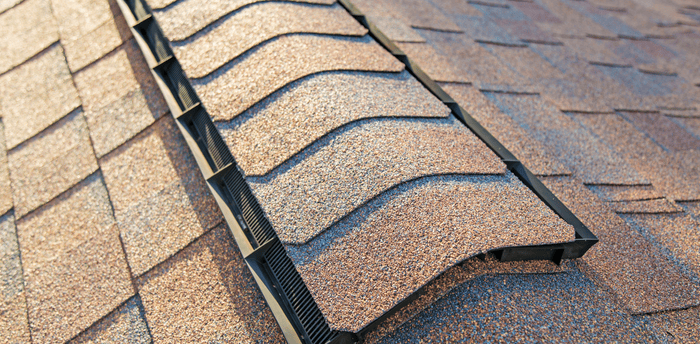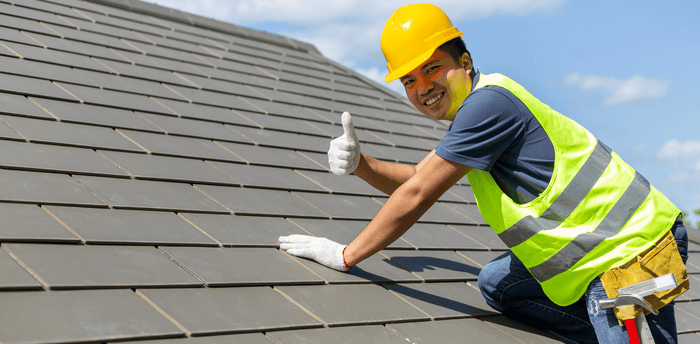Does your home feel hotter than it should in the summer? Or maybe you are noticing moisture issues in your attic during the winter? These could be warning signs of poor roof ventilation. Roof ventilation in California is key to maintaining a healthy and efficient home. Good attic ventilation helps control temperature and moisture.
Roofing isn’t just about shingles. It’s about a system that protects your home, and understanding the nuances of roof ventilation in California is paramount. In California, your roof does more than keep the rain out. It also functions as the “lungs” of your home, moving hot or humid air out of the attic space.
Table of Contents
Why Roof Ventilation Matters in California
California’s diverse climate, from scorching summers to damp winters, can take a toll on your roof. Proper attic ventilation helps prevent many issues, which makes the roof vent an important feature. A good ventilation system provides a balance between air intake vents and air exhaust.
Preventing Heat Buildup
Summer heat can turn your attic space into an oven, but the right roof vents keep this from happening. When attics get excessively hot, it causes premature aging of the roofing materials. This, in turn, damages wood roof framing members , siding, as well as interior and exterior paint.
During the summer months, the temperature of the roof goes up significantly. The solar heat, combined with high humidity, puts stress on shingles. With effective roof ventilation you can also reduce extra load it puts on your air conditioner. It helps with keeping your house cool while making sure your house is properly ventilated, and saves you money in energy costs.
Combating Moisture Issues
Winter brings its own challenges. The ventilation required helps to exhaust moisture. In winter, poor attic ventilation can cause moisture to build up and collect under your roof. Then the warm, moist air hits the cold roof which condenses into water, which damages wood.
The result of moisture build up in an attic space can also promote mold growth and deterioration of your insulation. The proper installation of soffit vents and ridge vents can drastically reduce these risks.
Extending Roof Lifespan
Maintaining good roof and attic ventilation isn’t hard, but failing to do so will have a detrimental effect on the longevity of the roof. Many things impact the lifespan of the roof: damage to wood, shingles, and the felt underlayment that waterproofs your roof.
A well-designed ventilation system provides continual airflow through your attic space. It does this by creating a balance between air intake vents and exhaust. This balance is what makes proper ventilation good.
Understanding California's Residential Code
California has specific requirements for roof ventilation. It’s important to know the California Residential Code if you are in the state.
Minimum Ventilation Area
California’s building code wants to make sure your attic has enough airflow. Building codes make sure there are at least two openings that let fresh air flow through your attic, called “cross-ventilation”. A good rule of thumb would be that for every 150 square feet of attic space, you should have 1 square foot of ventilation.
To determine your roof’s ventilation requirements, you’ll need to calculate the minimum net free ventilation area (NFVA). The standard rule is the ‘1/150 rule’: for every 150 square feet of attic floor space, you need 1 square foot of NFVA.
Standard Calculation (1/150 Rule):
- Measure the total square footage of your attic floor.
- Divide that number by 150.
- The result is the minimum NFVA you need in square feet.
Exceptions (1/300 Rule):
- In certain situations, you can use the ‘1/300 rule,’ which requires only 1 square foot of NFVA for every 300 square feet of attic space.
- These exceptions typically apply when both of the following conditions are met:
- A vapor retarder is installed on the warm-in-winter side of the ceiling. (This barrier prevents moisture from moving from the living space into the attic.)
- At least 50% of the required ventilation is in the upper portion of the attic. (This ensures effective removal of hot, moist air.)
Calculation for exception:
- Measure the total square footage of your attic floor.
- Divide that number by 300.
- The result is the minimum NFVA you need in square feet.
Detailed Calculation Steps (Applicable to both 1/150 and 1/300):
- Measure your ventilated attic area in square feet.
- Divide the square footage by 150 (or 300 if you meet the exception). This will give you the required ventilation area in square feet.
- Convert this area to square inches by multiplying by 144 (since there are 144 square inches in a square foot).
- Find the net free area of your vents with information from the manufacturer.
- Divide the total ventilation area in square inches by the net free area per vent to find how many vents you need.
Important Note: Always consult your local building codes or a professional roofing contractor to confirm which rule applies to your specific situation and to ensure compliance. Building codes can vary, and professionals can accurately assess your attic’s specific needs.
Vent Types and Placement
The placement of vents matters just as much as the amount of ventilation. California’s residential code focuses on upper and lower ventilation to make sure air flows properly. The California Residential Code protects houses through its specifications.
Upper Vents
Upper vents, designed to exhaust hot air, should ideally be installed within 3 feet of the roof’s ridge, which is the highest point of the attic space. However, if roof framing members obstruct this placement, the vents can be positioned further down. Upper vents should provide 40% to 50% of the total required ventilation area to ensure effective hot air removal. They are most effective when located in the upper portion of the rafter space, near the ridge.
When planning upper vent placement, carefully consider potential obstructions from roof framing members. This careful planning ensures optimal airflow and compliance with building codes.
Lower Vents
Lower vents, primarily soffit vents, should be positioned within the bottom third of the attic space to ensure proper air intake. These vents draw in cooler, fresh air, which then circulates through the attic and is expelled by the upper vents. When installing lower vents, consider the placement of wall and roof framing to avoid obstructions.
Proper positioning of soffit vents allows for optimal air intake and contributes to balanced attic ventilation. This balanced system, with effective intake and exhaust vents, maximizes airflow and minimizes potential conflicts with roof framing during installation.
Materials and Construction
California’s residential code specifies material and construction standards for roof vents. To prevent animal and insect intrusion, vents must be screened with corrosion-resistant wire cloth or hardware cloth.
The code mandates that vent openings have a net free dimension of at least 1/16 inch and no more than 1/4 inch. For openings exceeding 1/4 inch, corrosion-resistant wire cloth or hardware cloth with openings within the 1/16-inch to 1/4-inch range must be used. (Net free dimension refers to the open area available for airflow, excluding the frame and screening.)
Using high-quality, code-compliant materials ensures the longevity and effectiveness of the ventilation system, thereby contributing to building safety.
Attic Access
California’s building codes require that attic spaces exceeding 30 square feet in area and 30 inches in vertical height must have an accessible opening.
Providing proper attic access ensures compliance with regulations and facilitates essential inspections and maintenance of the ventilation system. Regular inspections of the attic space are crucial for verifying the system’s performance.
Common Types of Roof Vents in California

California homes utilize various roof vent types, each designed to address specific ventilation needs. Proper placement and selection of these vents are crucial for effective attic airflow.
- Ridge Vents: Installed along the roof’s peak, ridge vents provide continuous exhaust, allowing hot air to escape the attic and maintaining a more consistent attic temperature.
- Soffit Vents: Located under the eaves, soffit vents serve as intake vents, drawing fresh, cooler air into the attic.
- Gable Vents: Positioned on the gable ends of the house, gable vents facilitate exhaust airflow.
- Roof Louvers (Box Vents): Individual vents mounted on the roof’s surface, roof louvers provide additional means of air movement.
A balanced ventilation system, incorporating both intake vents (such as soffit vents) and exhaust vents (such as ridge vents), is essential for optimal attic airflow and proper ventilation
How to Determine Your Roof Ventilation Needs
Determining if your roof has enough ventilation can be tricky. Look for telltale signs that show how well the roof is breathing.
- Check for Moisture: Go into your attic and check for condensation. Condensation is a clear sign of inadequate ventilation.
- Assess Insulation: Inadequate ventilation can result in damp insulation, which compromises its effectiveness. This diminished insulation performance reduces the efficiency of your home’s heating and cooling systems.
- Look at Shingles: Are your shingles buckling or curling? These can be signs of overheating, caused by the lack of roof vents.
- Professional Inspection: If unsure, get help. Roofing inspectors can spot weaknesses in your system.
Don’t assume that vents already mean proper ventilation. A professional can assess your current ventilation area and suggest improvements.
Tips for Improving Roof Ventilation
If you suspect inadequate roof ventilation, consider the following strategies to enhance airflow:
- Increase Vent Capacity: Adding soffit vents or ridge vents can significantly improve airflow in attics with insufficient ventilation. Ensure a balanced ratio of intake and exhaust vents when implementing additions.
- Clear Obstructions: Regularly inspect and remove any obstructions, such as insulation or debris, that may block vent openings. Maintaining clear airflow pathways is crucial for optimal ventilation.
- Optimize Insulation and Air Sealing: Seal any air leaks between the house and the attic to prevent moisture intrusion. Proper insulation and air sealing contribute to the overall effectiveness of the ventilation system.
The Importance of Professional Installation

While DIY roof ventilation installation may seem appealing, engaging a professional is strongly recommended. Expert installers possess a thorough understanding of building codes and can accurately assess your attic’s ventilation requirements, ensuring optimal performance.
Furthermore, many homes built before the 1980s contain asbestos in roofing, insulation, and siding materials. Professionals are trained to safely handle and remove these hazardous materials, safeguarding both human health and building integrity.
Incorrect installation can lead to reduced ventilation efficiency and even roof damage. A professional roofing company will conduct a comprehensive assessment of your roof’s condition, provide a detailed installation proposal, and ensure proper worksite cleanup.
DIY Risks vs. Professional Advantages
| Issue | DIY Risk | Professional Advantage |
|---|---|---|
| Incorrect Installation | Can lead to reduced ventilation or roof damage. | Ensures proper installation and adherence to building codes. |
| Material Selection | May result in selecting inappropriate vent types for your home. | Selects appropriate vents based on roof design and climate. |
| Safety Hazards | Increased risk of falls or injuries. | Trained to handle asbestos safely and efficiently. |
| Long-Term Costs | Potential for future repairs due to improper ventilation. | Reduces the risk of costly repairs. |
Frequently Asked Questions
Here are some frequently asked questions about roof ventilation:
How do I know if my attic is properly ventilated?
Check for signs of moisture, such as condensation or water stains, in your attic space. Also, assess your insulation for dampness and look for shingle damage.
What is the 1/150 rule for ventilation?
The 1/150 rule states that you need 1 square foot of net free ventilation area for every 150 square feet of attic space. Exceptions allow for 1/300 if specific conditions are met. (These conditions are having a vapor retarder installed, and having 50% of the ventilation in the upper portion of the attic.)
Can I mix different types of vents on my roof?
Yes, but it’s crucial to balance intake vents and exhaust vents for optimal airflow. Mixing vents without proper planning can lead to ineffective ventilation.
How often should I inspect my roof ventilation system?
It’s recommended to inspect your system at least twice a year, typically in the spring and fall, to ensure proper ventilation and address any issues promptly.
What are the benefits of ridge vents?
Ridge vents provide continuous ventilation along the highest point of your roof, allowing hot air to escape efficiently. They help maintain a consistent temperature and reduce moisture buildup in the attic space.
When should I seek professional help for roof ventilation issues?
If you notice persistent moisture problems, have concerns about asbestos, or are unsure about how to properly calculate or install your ventilation system, consult a qualified roofing professional.
Conclusion
Maintaining a well-ventilated home in California begins with a thorough understanding of your roof, local building codes, and the state’s diverse climate. By investing time in assessing your home’s specific needs and selecting the appropriate system for roof ventilation in California, you can ensure a comfortable and energy-efficient living space for years to come. If you observe signs of moisture buildup or excessive attic temperatures, address the issue promptly. And when in doubt, consult a qualified roofing professional, such as Simpli Services to ensure proper installation and compliance.



0 Comments